2016 FORD F SERIES MOTORHOME AND COMMERCIAL CHASSIS weight
[x] Cancel search: weightPage 102 of 154
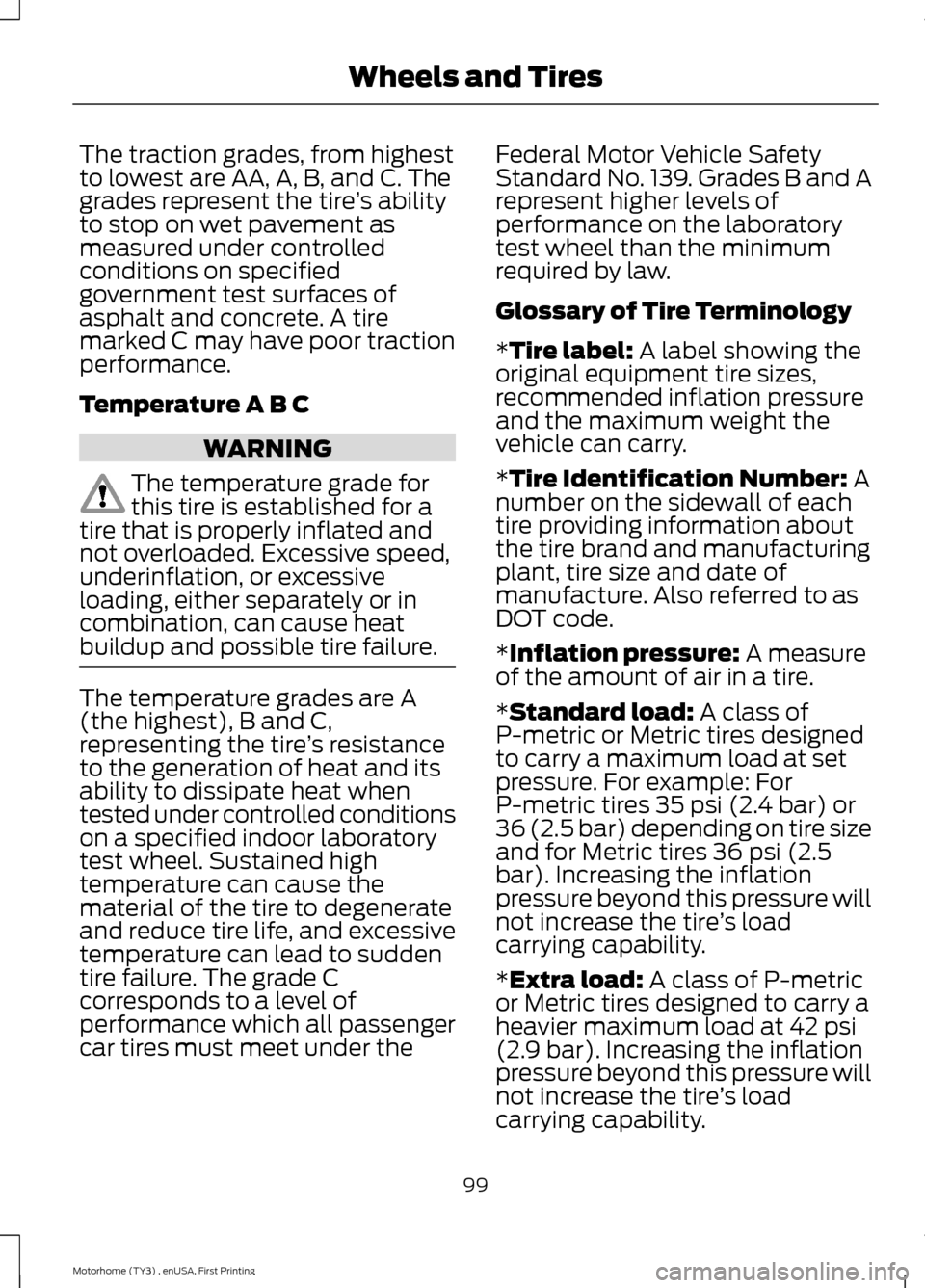
The traction grades, from highestto lowest are AA, A, B, and C. Thegrades represent the tire’s abilityto stop on wet pavement asmeasured under controlledconditions on specifiedgovernment test surfaces ofasphalt and concrete. A tiremarked C may have poor tractionperformance.
Temperature A B C
WARNING
The temperature grade forthis tire is established for atire that is properly inflated andnot overloaded. Excessive speed,underinflation, or excessiveloading, either separately or incombination, can cause heat
buildup and possible tire failure.
The temperature grades are A(the highest), B and C,representing the tire’s resistanceto the generation of heat and itsability to dissipate heat whentested under controlled conditionson a specified indoor laboratorytest wheel. Sustained hightemperature can cause thematerial of the tire to degenerateand reduce tire life, and excessivetemperature can lead to suddentire failure. The grade Ccorresponds to a level ofperformance which all passengercar tires must meet under the
Federal Motor Vehicle SafetyStandard No. 139. Grades B and Arepresent higher levels ofperformance on the laboratorytest wheel than the minimumrequired by law.
Glossary of Tire Terminology
*Tire label: A label showing theoriginal equipment tire sizes,recommended inflation pressureand the maximum weight thevehicle can carry.
*Tire Identification Number: Anumber on the sidewall of eachtire providing information aboutthe tire brand and manufacturingplant, tire size and date ofmanufacture. Also referred to asDOT code.
*Inflation pressure: A measureof the amount of air in a tire.
*Standard load: A class ofP-metric or Metric tires designedto carry a maximum load at setpressure. For example: ForP-metric tires 35 psi (2.4 bar) or36 (2.5 bar) depending on tire sizeand for Metric tires 36 psi (2.5bar). Increasing the inflationpressure beyond this pressure willnot increase the tire’s loadcarrying capability.
*Extra load: A class of P-metricor Metric tires designed to carry aheavier maximum load at 42 psi(2.9 bar). Increasing the inflationpressure beyond this pressure willnot increase the tire’s loadcarrying capability.
99Motorhome (TY3) , enUSA, First PrintingWheels and Tires
Page 104 of 154
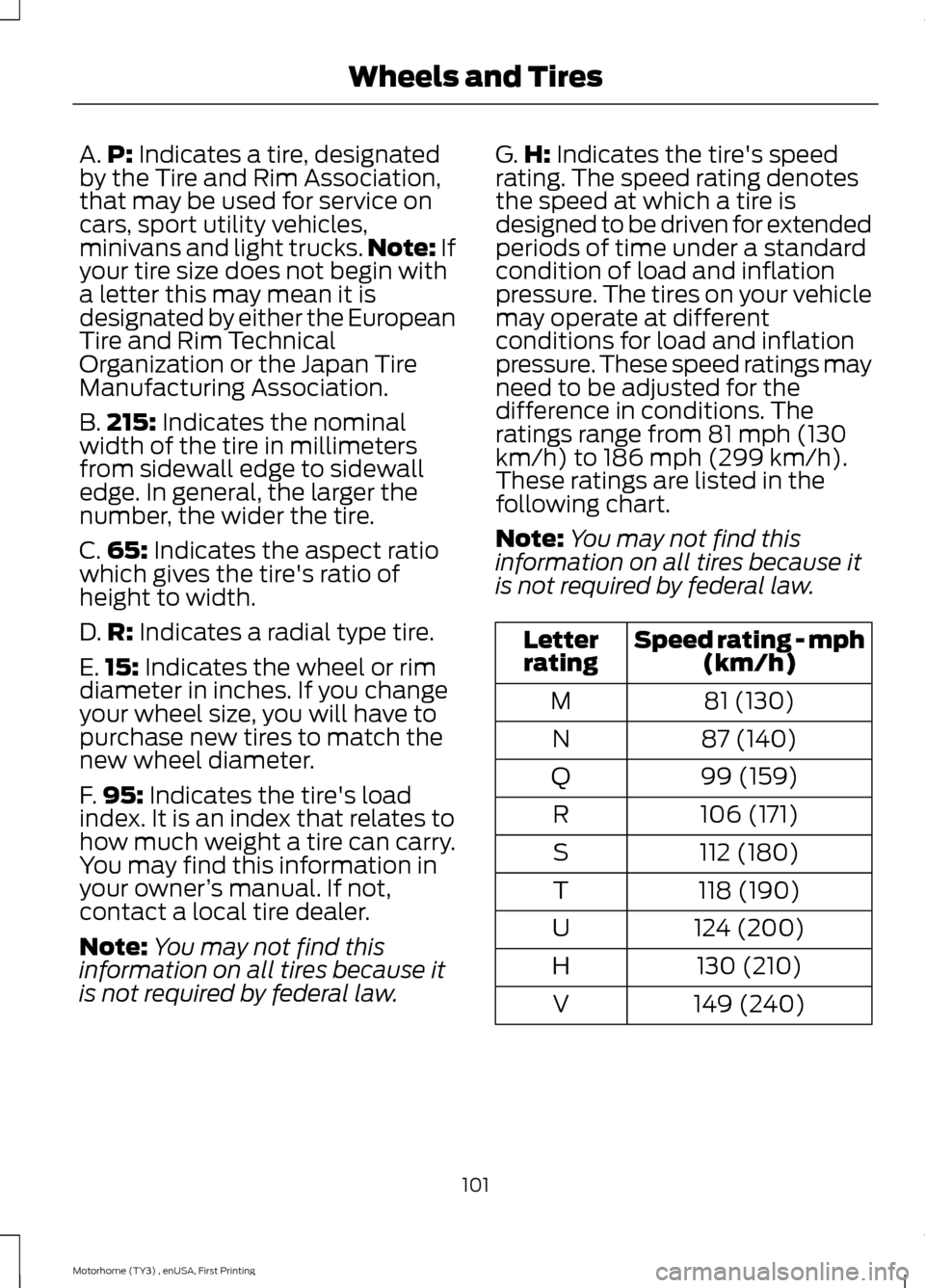
A.P: Indicates a tire, designatedby the Tire and Rim Association,that may be used for service oncars, sport utility vehicles,minivans and light trucks.Note: Ifyour tire size does not begin witha letter this may mean it isdesignated by either the EuropeanTire and Rim TechnicalOrganization or the Japan TireManufacturing Association.
B.215: Indicates the nominalwidth of the tire in millimetersfrom sidewall edge to sidewalledge. In general, the larger thenumber, the wider the tire.
C.65: Indicates the aspect ratiowhich gives the tire's ratio ofheight to width.
D.R: Indicates a radial type tire.
E.15: Indicates the wheel or rimdiameter in inches. If you changeyour wheel size, you will have topurchase new tires to match thenew wheel diameter.
F.95: Indicates the tire's loadindex. It is an index that relates tohow much weight a tire can carry.You may find this information inyour owner’s manual. If not,contact a local tire dealer.
Note:You may not find thisinformation on all tires because itis not required by federal law.
G.H: Indicates the tire's speedrating. The speed rating denotesthe speed at which a tire isdesigned to be driven for extendedperiods of time under a standardcondition of load and inflationpressure. The tires on your vehiclemay operate at differentconditions for load and inflationpressure. These speed ratings mayneed to be adjusted for thedifference in conditions. Theratings range from 81 mph (130km/h) to 186 mph (299 km/h).These ratings are listed in thefollowing chart.
Note:You may not find thisinformation on all tires because itis not required by federal law.
Speed rating - mph(km/h)Letterrating
81 (130)M
87 (140)N
99 (159)Q
106 (171)R
112 (180)S
118 (190)T
124 (200)U
130 (210)H
149 (240)V
101Motorhome (TY3) , enUSA, First PrintingWheels and Tires
Page 118 of 154
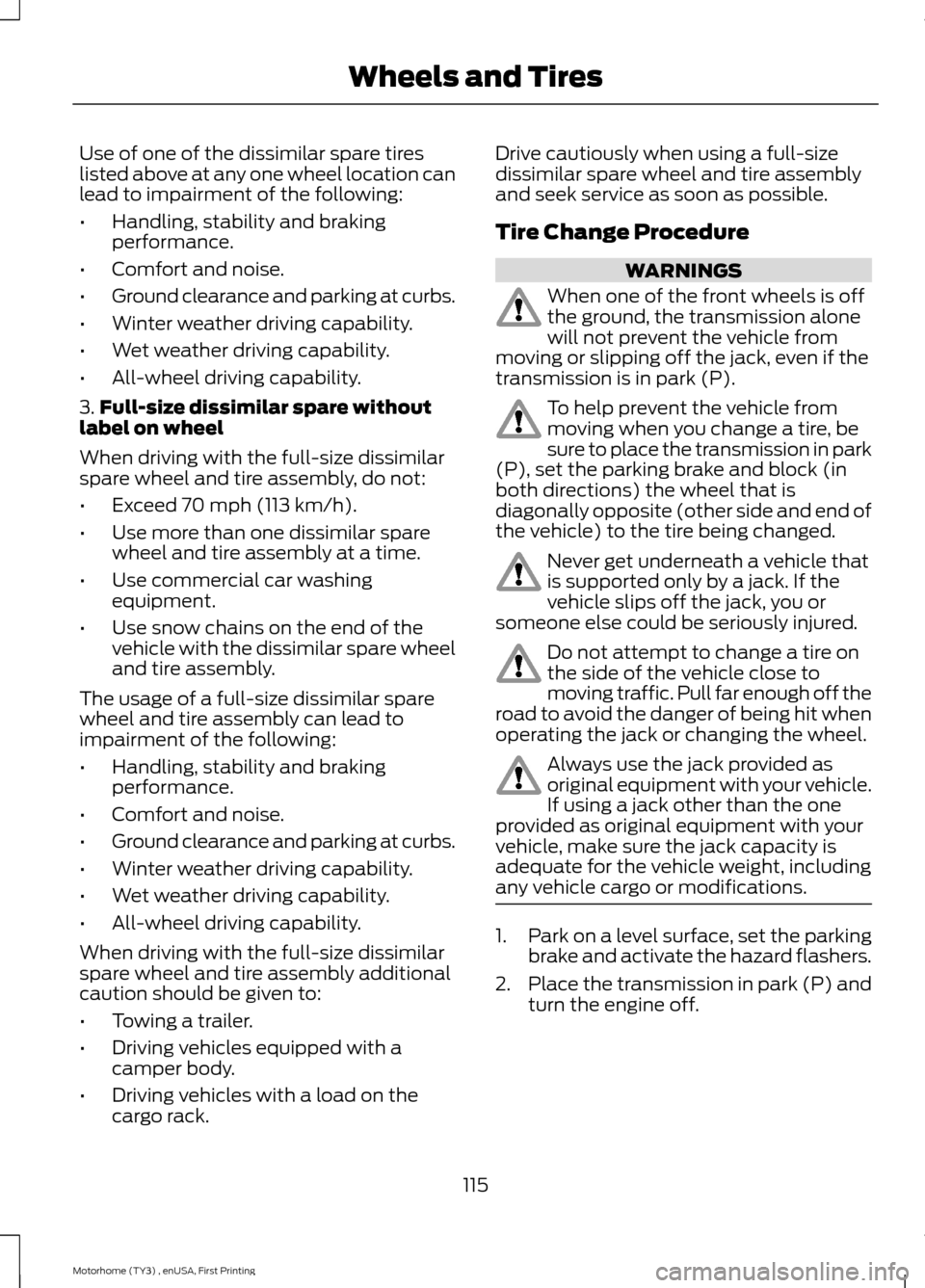
Use of one of the dissimilar spare tireslisted above at any one wheel location canlead to impairment of the following:
•Handling, stability and brakingperformance.
•Comfort and noise.
•Ground clearance and parking at curbs.
•Winter weather driving capability.
•Wet weather driving capability.
•All-wheel driving capability.
3.Full-size dissimilar spare withoutlabel on wheel
When driving with the full-size dissimilarspare wheel and tire assembly, do not:
•Exceed 70 mph (113 km/h).
•Use more than one dissimilar sparewheel and tire assembly at a time.
•Use commercial car washingequipment.
•Use snow chains on the end of thevehicle with the dissimilar spare wheeland tire assembly.
The usage of a full-size dissimilar sparewheel and tire assembly can lead toimpairment of the following:
•Handling, stability and brakingperformance.
•Comfort and noise.
•Ground clearance and parking at curbs.
•Winter weather driving capability.
•Wet weather driving capability.
•All-wheel driving capability.
When driving with the full-size dissimilarspare wheel and tire assembly additionalcaution should be given to:
•Towing a trailer.
•Driving vehicles equipped with acamper body.
•Driving vehicles with a load on thecargo rack.
Drive cautiously when using a full-sizedissimilar spare wheel and tire assemblyand seek service as soon as possible.
Tire Change Procedure
WARNINGS
When one of the front wheels is offthe ground, the transmission alonewill not prevent the vehicle frommoving or slipping off the jack, even if thetransmission is in park (P).
To help prevent the vehicle frommoving when you change a tire, besure to place the transmission in park(P), set the parking brake and block (inboth directions) the wheel that isdiagonally opposite (other side and end ofthe vehicle) to the tire being changed.
Never get underneath a vehicle thatis supported only by a jack. If thevehicle slips off the jack, you orsomeone else could be seriously injured.
Do not attempt to change a tire onthe side of the vehicle close tomoving traffic. Pull far enough off theroad to avoid the danger of being hit whenoperating the jack or changing the wheel.
Always use the jack provided asoriginal equipment with your vehicle.If using a jack other than the oneprovided as original equipment with yourvehicle, make sure the jack capacity isadequate for the vehicle weight, includingany vehicle cargo or modifications.
1.Park on a level surface, set the parkingbrake and activate the hazard flashers.
2.Place the transmission in park (P) andturn the engine off.
115Motorhome (TY3) , enUSA, First PrintingWheels and Tires
Page 123 of 154
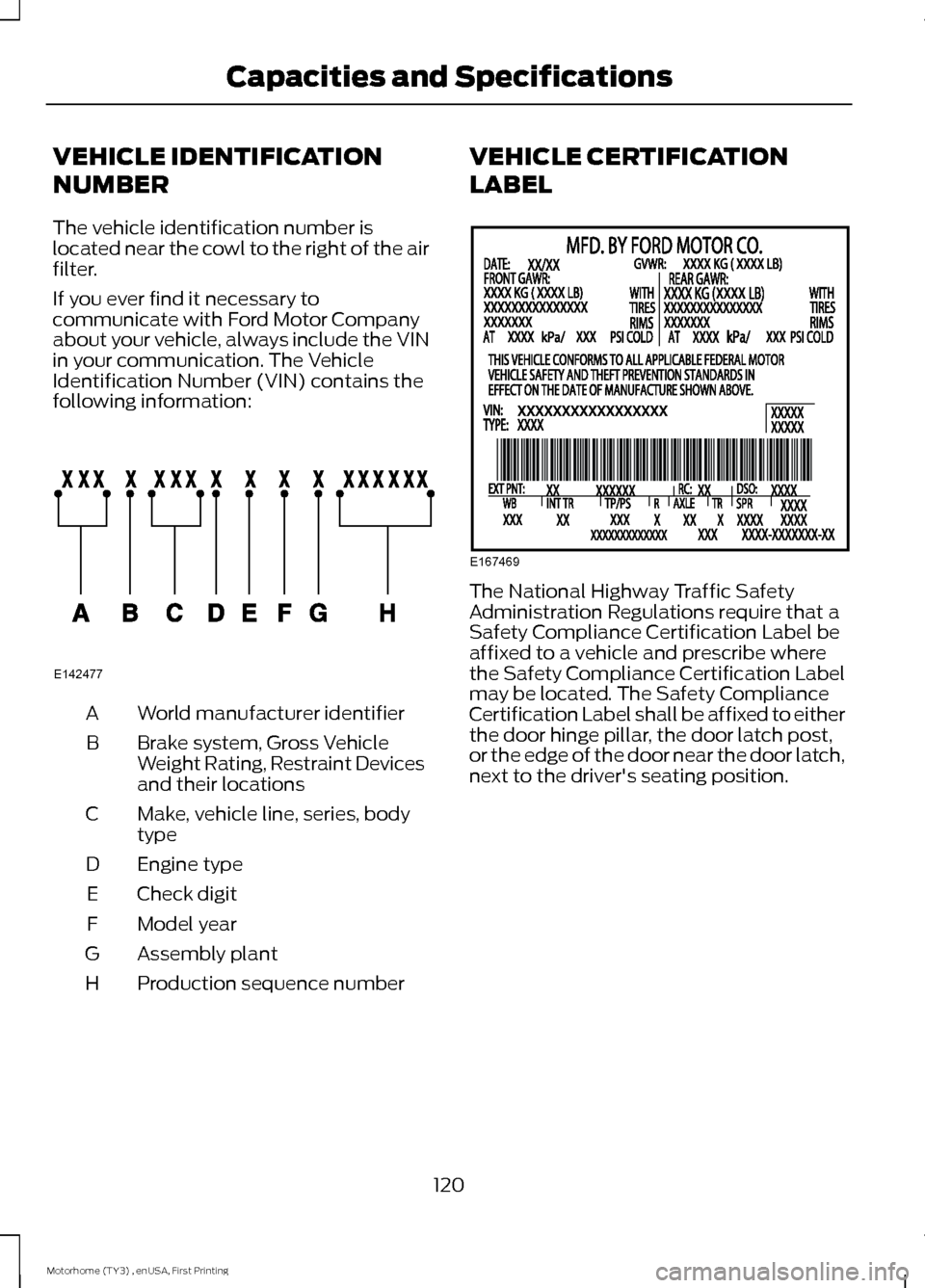
VEHICLE IDENTIFICATION
NUMBER
The vehicle identification number islocated near the cowl to the right of the airfilter.
If you ever find it necessary tocommunicate with Ford Motor Companyabout your vehicle, always include the VINin your communication. The VehicleIdentification Number (VIN) contains thefollowing information:
World manufacturer identifierA
Brake system, Gross VehicleWeight Rating, Restraint Devicesand their locations
B
Make, vehicle line, series, bodytypeC
Engine typeD
Check digitE
Model yearF
Assembly plantG
Production sequence numberH
VEHICLE CERTIFICATION
LABEL
The National Highway Traffic SafetyAdministration Regulations require that aSafety Compliance Certification Label beaffixed to a vehicle and prescribe wherethe Safety Compliance Certification Labelmay be located. The Safety ComplianceCertification Label shall be affixed to eitherthe door hinge pillar, the door latch post,or the edge of the door near the door latch,next to the driver's seating position.
120Motorhome (TY3) , enUSA, First PrintingCapacities and SpecificationsE142477 E167469
Page 127 of 154
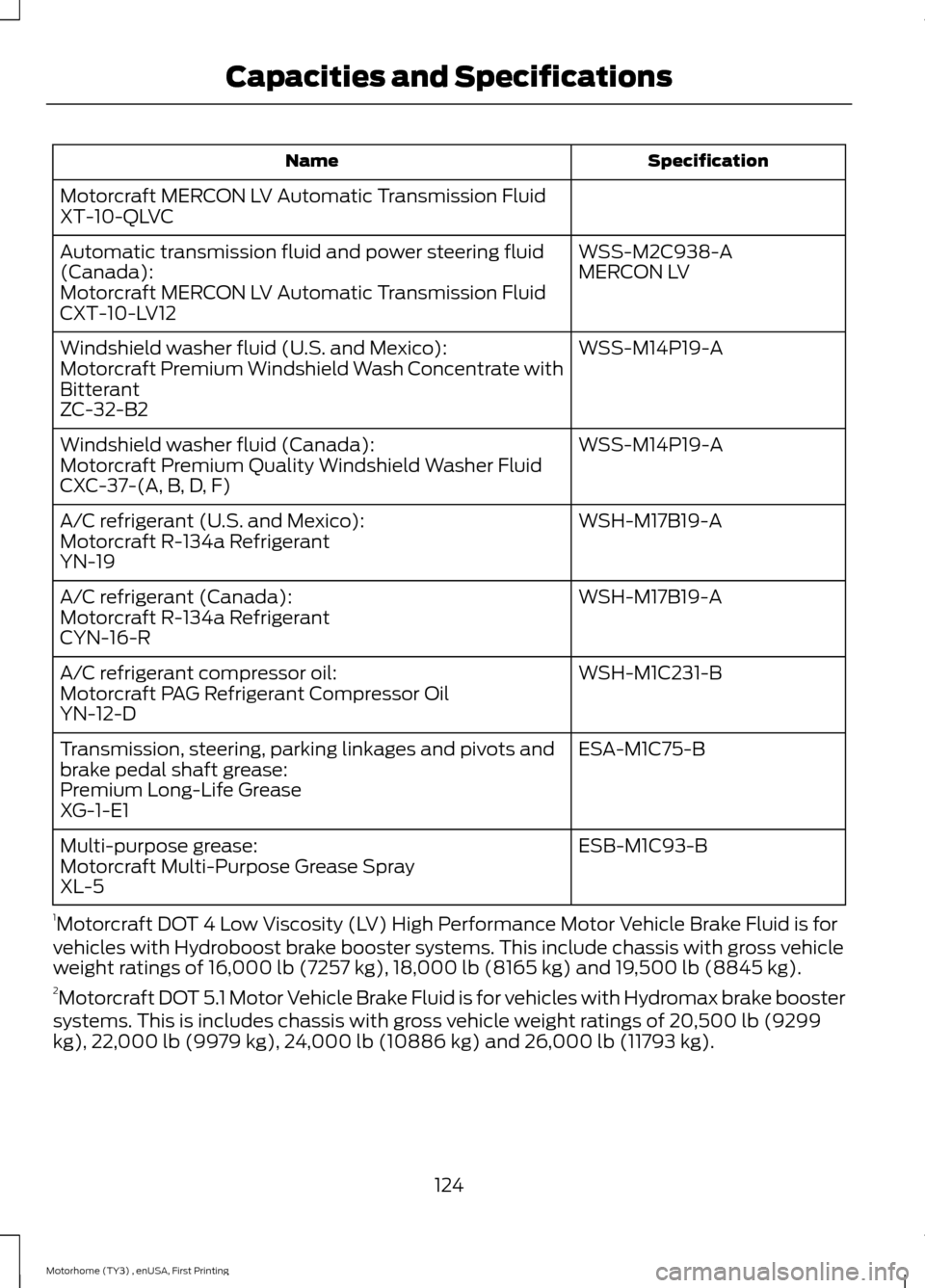
SpecificationName
Motorcraft MERCON LV Automatic Transmission FluidXT-10-QLVC
WSS-M2C938-AAutomatic transmission fluid and power steering fluid(Canada):MERCON LVMotorcraft MERCON LV Automatic Transmission FluidCXT-10-LV12
WSS-M14P19-AWindshield washer fluid (U.S. and Mexico):Motorcraft Premium Windshield Wash Concentrate withBitterantZC-32-B2
WSS-M14P19-AWindshield washer fluid (Canada):Motorcraft Premium Quality Windshield Washer FluidCXC-37-(A, B, D, F)
WSH-M17B19-AA/C refrigerant (U.S. and Mexico):Motorcraft R-134a RefrigerantYN-19
WSH-M17B19-AA/C refrigerant (Canada):Motorcraft R-134a RefrigerantCYN-16-R
WSH-M1C231-BA/C refrigerant compressor oil:Motorcraft PAG Refrigerant Compressor OilYN-12-D
ESA-M1C75-BTransmission, steering, parking linkages and pivots andbrake pedal shaft grease:Premium Long-Life GreaseXG-1-E1
ESB-M1C93-BMulti-purpose grease:Motorcraft Multi-Purpose Grease SprayXL-5
1Motorcraft DOT 4 Low Viscosity (LV) High Performance Motor Vehicle Brake Fluid is forvehicles with Hydroboost brake booster systems. This include chassis with gross vehicleweight ratings of 16,000 lb (7257 kg), 18,000 lb (8165 kg) and 19,500 lb (8845 kg).2Motorcraft DOT 5.1 Motor Vehicle Brake Fluid is for vehicles with Hydromax brake boostersystems. This is includes chassis with gross vehicle weight ratings of 20,500 lb (9299kg), 22,000 lb (9979 kg), 24,000 lb (10886 kg) and 26,000 lb (11793 kg).
124Motorhome (TY3) , enUSA, First PrintingCapacities and Specifications
Page 152 of 154
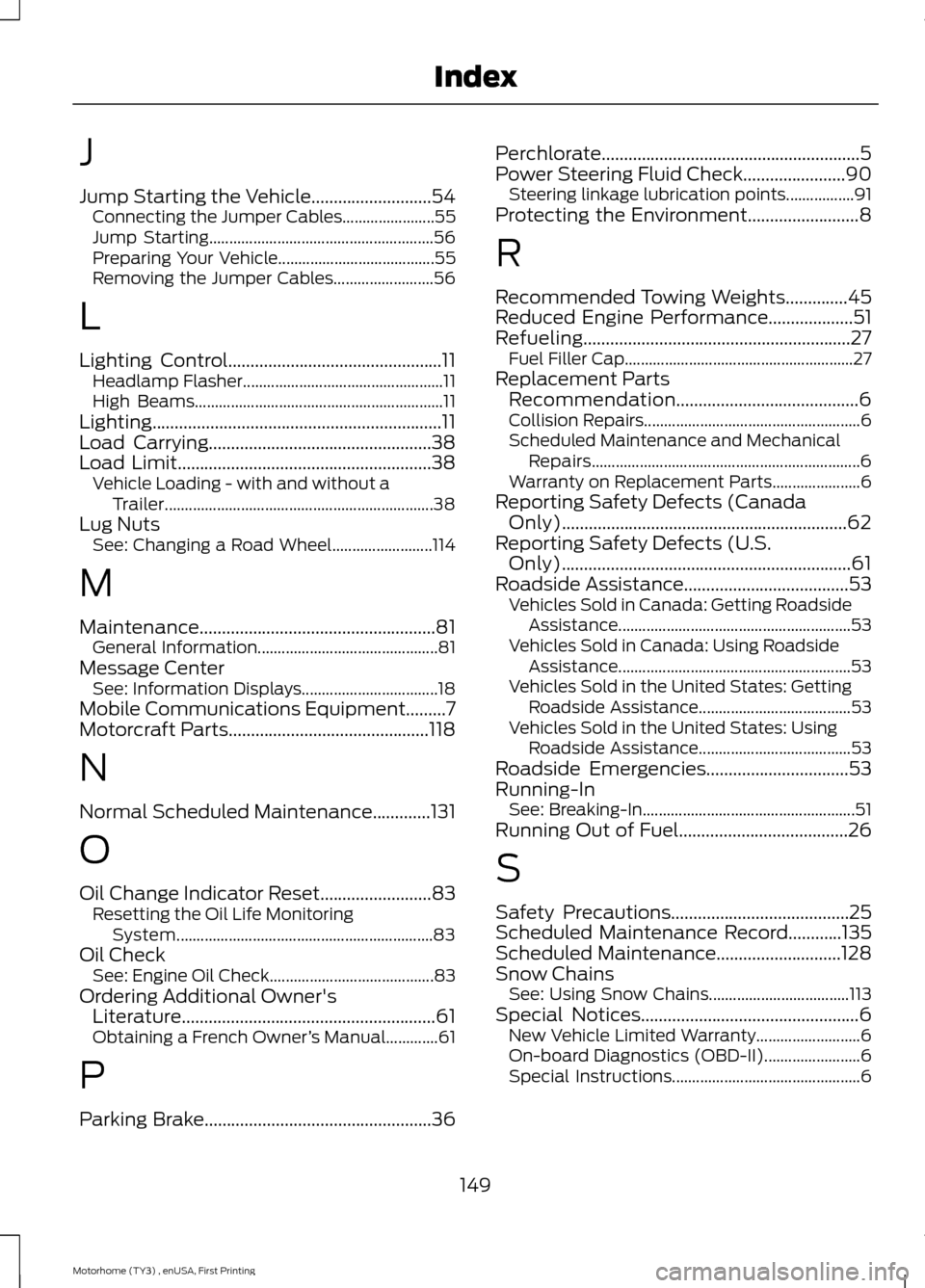
J
Jump Starting the Vehicle...........................54Connecting the Jumper Cables.......................55Jump Starting........................................................56Preparing Your Vehicle.......................................55Removing the Jumper Cables.........................56
L
Lighting Control................................................11Headlamp Flasher..................................................11High Beams..............................................................11Lighting.................................................................11Load Carrying..................................................38Load Limit.........................................................38Vehicle Loading - with and without aTrailer...................................................................38Lug NutsSee: Changing a Road Wheel.........................114
M
Maintenance.....................................................81General Information.............................................81Message CenterSee: Information Displays..................................18Mobile Communications Equipment.........7Motorcraft Parts.............................................118
N
Normal Scheduled Maintenance.............131
O
Oil Change Indicator Reset.........................83Resetting the Oil Life MonitoringSystem................................................................83Oil CheckSee: Engine Oil Check.........................................83Ordering Additional Owner'sLiterature.........................................................61Obtaining a French Owner’s Manual.............61
P
Parking Brake...................................................36
Perchlorate..........................................................5Power Steering Fluid Check.......................90Steering linkage lubrication points.................91Protecting the Environment.........................8
R
Recommended Towing Weights..............45Reduced Engine Performance...................51Refueling............................................................27Fuel Filler Cap.........................................................27Replacement PartsRecommendation.........................................6Collision Repairs......................................................6Scheduled Maintenance and MechanicalRepairs...................................................................6Warranty on Replacement Parts......................6Reporting Safety Defects (CanadaOnly)................................................................62Reporting Safety Defects (U.S.Only).................................................................61Roadside Assistance.....................................53Vehicles Sold in Canada: Getting RoadsideAssistance..........................................................53Vehicles Sold in Canada: Using RoadsideAssistance..........................................................53Vehicles Sold in the United States: GettingRoadside Assistance......................................53Vehicles Sold in the United States: UsingRoadside Assistance......................................53Roadside Emergencies................................53Running-InSee: Breaking-In.....................................................51Running Out of Fuel......................................26
S
Safety Precautions........................................25Scheduled Maintenance Record............135Scheduled Maintenance............................128Snow ChainsSee: Using Snow Chains...................................113Special Notices.................................................6New Vehicle Limited Warranty..........................6On-board Diagnostics (OBD-II)........................6Special Instructions...............................................6
149Motorhome (TY3) , enUSA, First PrintingIndex